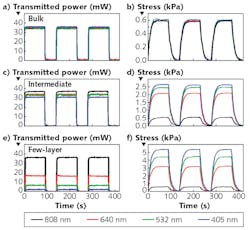
Researchers have used organic photochromic compounds, certain ceramics, and carbon-nanotube (CNT) and metallic-nanoparticle-infused polymers to convert photons into mechanical motion for practical applications in microrobotic actuators, grippers, and motors. However, the motion is typically triggered by near-infrared light and/or is not wavelength-specific, limiting the strength and types of motion that can be accomplished.
Now, researchers at Worcester Polytechnic Institute (WPI; Worcester, MA) have succeeded in creating wavelength-specific conversion of photons into mechanical motion using layered transition-metal di-chalcogenide (TMD) materials. Specifically, molybdenum sulfide (MoS2) has very strong optical absorption and exhibits a direct chromatic mechanical response that varies as a function of wavelength when illuminated by light from 405 to 808 nm. The mechanical response varies as a function of wavelength and power transmitted through the samples, which were fabricated with up to 10, 30, and even 500 layers of TMDs. Absorption spectroscopy and a dynamometer test revealed a chromatic mechanical response force up to 30 mN better than competing material options.
Applying uniaxial tensile strains to the semiconducting few-layer 2H-MoS2 crystals in the nanocomposite increased optical absorption between 808 and 640 nm. The unique photon-induced mechanical motion is a result of the rich d-electron physics not available to nanocomposites based on sp-bonded graphene and CNTs, as well as metallic nanoparticle composites. The reversible strain-dependent optical absorption suggests applications in a broad range of energy-conversion technologies that are not possible using conventional thin-film semiconductors. Reference: V. Rahneshin et al., Nature Sci. Rep., 6, 34831 (Oct. 7, 2016).
About the Author

Gail Overton
Senior Editor (2004-2020)
Gail has more than 30 years of engineering, marketing, product management, and editorial experience in the photonics and optical communications industry. Before joining the staff at Laser Focus World in 2004, she held many product management and product marketing roles in the fiber-optics industry, most notably at Hughes (El Segundo, CA), GTE Labs (Waltham, MA), Corning (Corning, NY), Photon Kinetics (Beaverton, OR), and Newport Corporation (Irvine, CA). During her marketing career, Gail published articles in WDM Solutions and Sensors magazine and traveled internationally to conduct product and sales training. Gail received her BS degree in physics, with an emphasis in optics, from San Diego State University in San Diego, CA in May 1986.